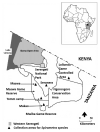Morphological and Molecular Identification of Spirometra Tapeworms (Cestoda: Diphyllobothriidae) from Carnivorous Mammals in the Serengeti and Selous Ecosystems of Tanzania
- PMID: 33412769
- PMCID: PMC7806435
- DOI: 10.3347/kjp.2020.58.6.653
Morphological and Molecular Identification of Spirometra Tapeworms (Cestoda: Diphyllobothriidae) from Carnivorous Mammals in the Serengeti and Selous Ecosystems of Tanzania
Abstract
Spirometra tapeworms (Cestoda: Diphyllobothriidae) collected from carnivorous mammals in Tanzania were identified by the DNA sequence analysis of the mitochondrial cytochrome c oxidase subunit 1 (cox1) and internal transcribed spacer 1 (ITS1), and by morphological characteristics. A total of 15 adult worms were collected from stool samples and carcasses of Panthera leo, Panthera pardus, and Crocuta crocuta in the Serengeti and Selous ecosystems of Tanzania. Three Spirometra species: S. theileri, S. ranarum and S. erinaceieuropaei were identified based on morphological features. Partial cox1 sequences (400 bp) of 10 specimens were revealed. Eight specimens showed 99.5% similarity with Spirometra theileri (MK955901), 1 specimen showed 99.5% similarity with the Korean S. erinaceieuropaei and 1 specimen had 99.5% similarity with Myanmar S. ranarum. Sequence homology estimates for the ITS1 region of S. theileri were 89.8% with S. erinaceieuropaei, 82.5% with S. decipiens, and 78.3% with S. ranarum; and 94.4% homology was observed between S. decipiens and S. ranarum. Phylogenetic analyses were performed with 4 species of Spirometra and 2 species of Dibothriocephalus (=Diphyllobothrium). By both ML and BI methods, cox1 and ITS1 gave well supported, congruent trees topology of S. erinaceieuropaei and S. theileri with S. decipiens and S. ranarum forming a clade. The Dibothriocephalus species were sisters of each other and collectively forming successive outgroups. Our findings confirmed that 3 Spirometra species (S. theileri, S. ranarum, and S. erinaceieuropaei) are distributed in the Serengeti and Selous ecosystems of Tanzania.
Keywords: ITS1; Spirometra erinaceieuropaei; Spirometra ranarum; Spirometra theileri; cox1.
Conflict of interest statement
The authors declare no conflict of interest related to this work.
Figures



References
-
- Nobrega-Lee M, Hubbard G, Loverde P, Carvalho-Queiroz C, Conn DB, Rohde K, Dick EJ, Jr, Nathanielsz P, Martin D, Siler-Khodr T, Schlabritz-Loutsevitch N. Sparganosis in wild-caught baboons (Papio cynocephalus anubis) J Med Primatol. 2007;36:47–54. doi: 10.1111/j.1600-0684.2006.00177.x. - DOI - PubMed
-
- Baer JG. Contribution à la faune helminthologique Sud-Africaine-Note préliminaire. Annales de Parasitologie. 1924;2:237–247. (in French)
-
- Contribution to the helminth fauna of South Africa . Mammalian cestodes. In: Baer JG, editor. 11th and 12th Report of the Director of Veterinary Education and Research. Pretoria, South Africa: Department of Agriculture; 1926. pp. 61–136.
-
- Baer JG, Fain A. Cestodes. Report d’Exploration Parcs Nationaux de I’Upemba. Fasc. 1955:36.
MeSH terms
Substances
Grants and funding
LinkOut - more resources
Full Text Sources

